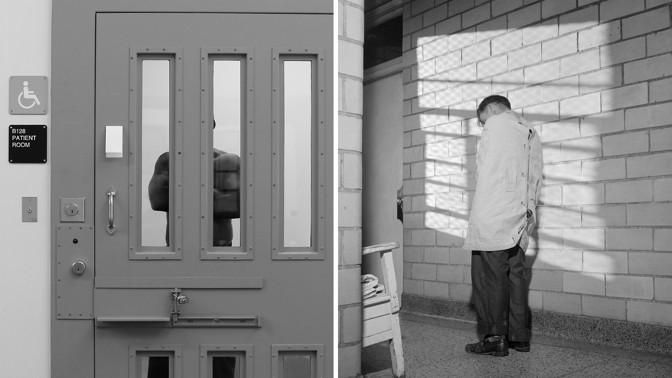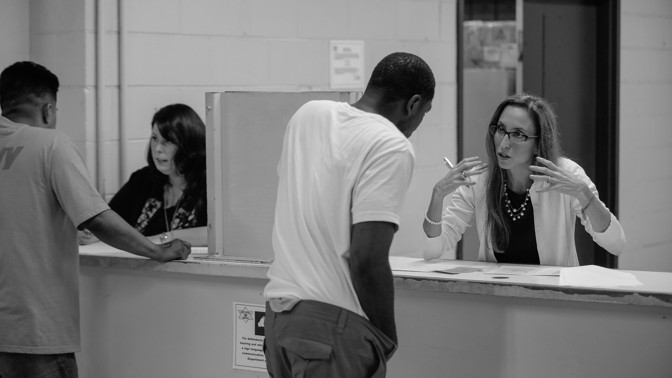The Real History of America’s Failed Mental-Health-Care System

iStock.com/fizkes
COMMENTARY | A popular theory links the closing of state psychiatric hospitals to the increased incarceration of people with mental illness. But the reality is more complicated.
This story was originally published by The Atlantic. Subscribe to the magazine’s newsletters.
When a person has a mental-health crisis in America, it is almost always law enforcement—not a therapist, social worker, or psychiatrist—who responds to the 911 call. But most officers aren’t adequately trained to deal with mental-health emergencies. And while laws intended to protect civil liberties make it exceedingly difficult to hospitalize people against their will, it is remarkably easy to arrest them.
As a result, policing and incarceration have effectively replaced emergency mental-health care, especially in low-income communities of color. In many jails, the percentage of people with mental illness has continued to go up even as the jail population has dropped. Today, nearly half the people in U.S. jails and more than a third of those in U.S. prisons have been diagnosed with a mental illness, compared to about a fifth in the general population.
When the justice system steps into mental-health care, the results are often deadly. According to a Washington Post database, nearly one-quarter of fatal police shootings involve a person with mental illness. Once inside a jail or prison, the mental-health care a person receives generally ranges from inadequate to abusive; suicide rates are disturbingly high. America’s criminal-justice system has a mental-illness crisis, and to fix it we need to understand how we got here.
One popular explanation blames “deinstitutionalization”: the emptying of state psychiatric hospitals that began in the 1950s. When the hospitals were shut down, the story goes, patients were discharged with no place to get psychiatric care. They ended up on the streets, eventually committing crimes that got them arrested. As a result, jails and prisons essentially became the new asylums. It’s an idea with roots in a theory developed in the 1930s by a British psychiatrist, Lionel Penrose, who argued that there was an inverse relationship between the number of people held in prisons and those in asylums. Today, the “Penrose hypothesis” is largely regarded by scholars and historians as an oversimplification of the problem, yet variations of it are regularly repeated in the media. The truth is far more complicated.
The first psychiatric hospital was established in 1773, but asylums were few and far between until the mid-1800s. In 1841, a former schoolteacher named Dorothea Dix visited a Massachusetts jail to teach a Bible class. She was appalled to find it filled with people with mental illness, living in horrific conditions; traveling around the country, she found similar conditions in other jails. Residents were kept in “cages, closets, cellars, stalls, pens!” she later wrote in a letter to the Massachusetts legislature. “Chained, naked, beaten with rods, and lashed into obedience!” She started lobbying states to create asylums, and eventually she helped establish or expand more than 30 institutions. Many more were created in the decades that followed; by the height of institutionalization in 1955, roughly half a million people were living in state-run psychiatric facilities.
These were designed to be safe, therapeutic places where people with mental illness could live quality, productive lives. Occasionally, they succeeded. Some self-sufficient asylum communities provided both employment and sustenance for residents: small-scale agricultural production, laundries, and bakeries.
But as more patients were moved into these institutions, the facilities quickly outgrew their capacity, and staff struggled just to keep up with patients’ needs. When a public psychiatric hospital in Worcester, Massachusetts, opened in 1833, for example, it had 120 beds. Just 13 years later, it had almost 400. The problem grew significantly worse during World War II, when many doctors and other staff were drafted, leaving the hospitals dangerously understaffed.

The resulting conditions looked remarkably similar to those seen in jails and prisons today. This was the beginning of the end for the state hospital system—but other factors sped it up. In 1954, the FDA approved the use of the antipsychotic drug chlorpromazine—also known by its trade name, Thorazine—to treat mental illnesses like schizophrenia and bipolar disorder. Its apparent ability to control psychosis—combined with a heavy marketing campaign that made it one of the first blockbuster drugs—helped promote the notion that mental illness could be cured with medication. Specialty inpatient psychiatric hospitals would no longer be needed because patients would no longer need the kind of intensive care they promised to provide.
Almost a decade later, President John F. Kennedy signed the Mental Retardation Facilities and Community Health Centers Construction Act. (It turned out to be the last bill Kennedy would sign.) Under the 1963 law, he said, “custodial mental institutions” would be replaced by community mental-health centers, thus allowing patients to live—and get psychiatric care—in their communities.
In 1965, the creation of Medicaid accelerated the shift from inpatient to outpatient care: One key part of the Medicaid legislation stipulated that the federal government would not pay for inpatient care in psychiatric hospitals. This further pushed states to move patients out of costly state facilities.
In reality, though, few community mental-health centers were built, creating an extreme shortage of mental-health care. Thorazine, initially touted as a miracle drug, soon proved to have serious side effects. More critical was the growing recognition that the treatment of mental illness is complicated: Conditions like bipolar disorder and schizophrenia cannot be “cured” with a simple drug regimen the way an antibiotic can knock out an infection. And Medicaid, now the largest payer of mental-health-care services in the country, has severely limited the number of inpatients that hospitals and other facilities can serve. The dream of community-based care turned out to be largely a failure.
It’s tempting to think that if the promises of deinstitutionalization had materialized—or if the state hospitals had never been shut down—far fewer people with mental illness would be in jails and prisons today. At first glance, the numbers seem to bear this out: The population of people living in asylums dropped from a high of more than half a million in 1955 to barely more than 100,000 in the mid-1980s. (Those numbers have continued to fall in the intervening years, and today there are negligible numbers of people in long-term psychiatric facilities.) As the asylum population steadily shrank, the number of incarcerated people grew.
The deinstitutionalization theory is also tempting because it points to a clear solution: If the lack of long-term inpatient beds drove large numbers of people with mental illness into jails and prisons, then presumably building more hospitals and community mental-health centers would solve the problem.
But the theory falls apart on closer scrutiny. It’s not the case that the majority of people with mental illness were suddenly on the streets when institutions closed: Even in 1950, only about a third of people with mental illness were living in psychiatric hospitals and other facilities. More than half already lived in communities, with family or on their own.
Furthermore, the vast majority of incarcerated people with mental illness belong to a subset of the population that likely would never have been served by state psychiatric hospitals in the past. State-hospital patients were largely white and middle-aged or older, and divided roughly evenly between men and women; today’s incarcerated population is largely young, male, and not white. (More than half of the U.S. prison population are people of color.) One study suggests that closing the state psychiatric facilities increased the incarcerated population by less than 10 percent.
So what accounts for the extraordinary levels of mental illness we see in our jails and prisons? In large part, the sheer number of incarcerated people. In a July 1971 press conference, President Richard Nixon declared a war on drugs, calling “drug abuse” America’s “public enemy number one” and setting the stage for tough-on-crime policies. These laws, like mandatory minimum sentences for possession and other drug-related crimes, disproportionately affected people of color and pushed incarceration rates to record levels. Between 1972 and 2009, the prison population alone grew 700 percent.

As huge numbers of people were swept into jails and prisons, logically many of them had mental illness. The crackdown on drug crimes made them especially vulnerable to incarceration. Substance use is common among people with mental illness, in part because it can serve as a form of self-medication. Around three-quarters of incarcerated people with mental illness are known to also have a substance-use disorder.
At the same time, the advent of “broken windows” policing in the 1980s—the idea that in order to prevent bigger crimes, police need to crack down on low-level quality-of-life crimes—disproportionately affected people with mental illness: A person acting erratically could be charged with disorderly conduct, or a person without access to a bathroom could be charged with public urination.
Tough-on-crime rhetoric also helped enforce the persistent assumption that people with mental illness are dangerous and need to be kept off the streets to protect the rest of us. Judges have told me repeatedly that they fear offering bail or other alternatives to people with mental illness lest the person in question end up on the front page after committing some heinous crime. But people with mental illness are far likelier to be victims than perpetrators of violence—and since police are the default first responders, it’s no surprise that people with mental illness are more likely to end up getting arrested.
In order to truly fix our broken approach to mental illness, there needs to be a change in attitude: one that goes from seeing people as inherently dangerous to treating them as human beings in need of help.
Recent years have seen a spate of police killings of people with mental illness, but also a renewed focus on law enforcement’s role in responding to mental-health crises. Attention has been heightened in the wake of recent episodes of police violence, including the death of Daniel Prude in March 2020, when officers were called to help him while he was in a psychotic state.
Police departments around the country have adopted training programs to teach officers how to respond to people in psychiatric distress. The most common model, the Crisis Intervention Team program, is being used in more than 2,500 communities nationwide—though there’s little empirical evidence of its success, and it’s unclear whether a few hours of instruction can overcome entrenched use-of-force practices. And some jurisdictions have gone a step further, dispatching mental-health workers to respond to 911 calls. In St. Paul, Minnesota, for example, social workers accompany specially trained police officers on mental-health-related calls, assessing needs and directing people to resources like counseling or shelters. In Eugene, Oregon, unarmed outreach workers and medics respond to many mental-health emergencies instead of officers. And programs that offer alternatives to incarceration have been growing, too. In the more than 300 mental-health courts across the country, people who agree to certain conditions—usually treatment, including medication and regular check-ins with a judge—can avoid jail and prison time.
But America has gone without a real system of mental-health care for so long that mental illness is often seen as a permanent feature of the criminal-justice system. In many prisons and jails, the urgent question is not how to reduce this surging population but how to build larger and better psychiatric units and treatment facilities inside the walls. Rikers Island, for example, now has specialized therapeutic units for people who might need hospitalization or who have just returned from a psychiatric hospital. While people with mental illness who do end up in the criminal-justice system have a constitutional right to adequate mental-health care, it would be far better to disentangle psychiatric care from the criminal-justice system in the first place.
It’s easy to think that if people with mental illness could be housed and treated in asylums or similar institutions, they wouldn’t be policed and incarcerated at such high rates. But it’s important to remember that those hospitals had deteriorated to conditions shockingly similar to today’s worst correctional facilities. Instead, we need to face head-on the enormous problems of mass incarceration and a system of mental-health care that effectively does not exist. No nostalgic looking back will change that.
Alisa Roth is a correspondent for APM Reports.
NEXT STORY: More States Consider Automatic Criminal Record Expungement





